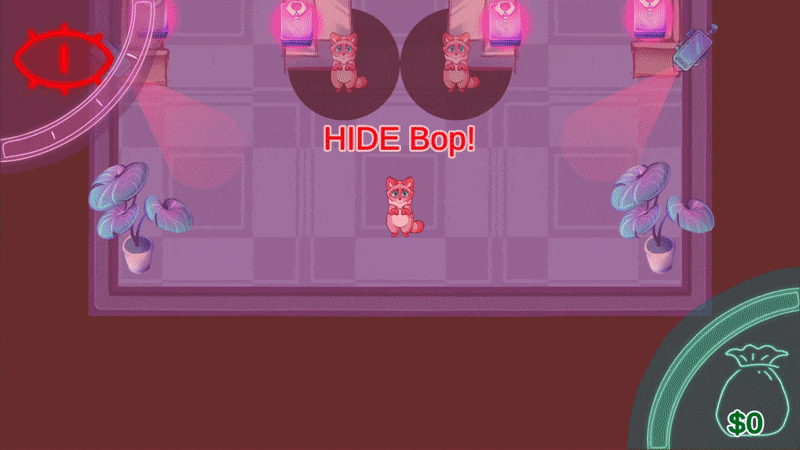.
.
RANSACK RACCOON
Game Designer
2D Action Stealth Game
.
Project Synopsis
Ransack Raccoon is a 2D action stealth game about stealing everything from a mall and escaping!Duration: 8 months
Team Size: 12
Tools: Custom EngineOn this project, I designed the main mechanics and UI layouts.
Main Mechanics
The main challenge of this project was creating a stealth game that was fast-paced "without enemies", as stealth games are typically slower-paced and methodical.
.
Problem Statement
.
Scope Limitations .
The development of the custom engine took a majority of the Tech team's resources, so enemy behavior like pathfinding was out of scope.
.
Problem statement: Create an engaging experience by making a stealth system without enemies.
.
Initial Approach .
The team's initial approach involved cameras that drained time from a time limit. However players found this boring. This called for a design pivot.
.
Solution 1
.
.

Identifying Issues .
The current solution did not reflect fast-paced gameplay, even with time pressure. We concluded that there was not enough threat/tension to challenge the player. We chose Persona 5's cover system as our inspiration for our design shift.

Flipping the System .
We severely limited safe areas, intending players to have brief periods of rest to solve how to navigate to the next safe zone. In testing, users did feel more urgency but it was not fun because there was too much pressure and it was frustrating.
.
Solution 2
.
Research .
I decided to look at fast-paced simple action games like Mario and World's Hardest Game. In these, the player feels tension, but it is not crippling like in our game. There should be motivation to keep moving, but there should be leniency to make errors and stop.
My Redesign .
I scoped down and simplified the game a lot. I changed camera to spotlights and reduced level sizes. I removed the timer. The macro-experience moved at the player's pace, while the micro-scale had the fast-paced action we were looking for.
.
I presented my proposal to the team and it was very positively received, and the team switched to this new direction.
.
.
User Testing
In testing, users were finally engaged. With audible excited reactions to barely avoiding a spotlight and sighs of relief when entering a "safe zone," the game was finally fun. My redesign was a success!
.
What I Learned
.
In solving this design challenge, I learned how to tackle problems regarding unfun experience by balancing player affordances with consequences, appropriately scope a simple design with lots of room for expansion, present design shifts to a team, and research games that fit the project and offer design solutions.
.
